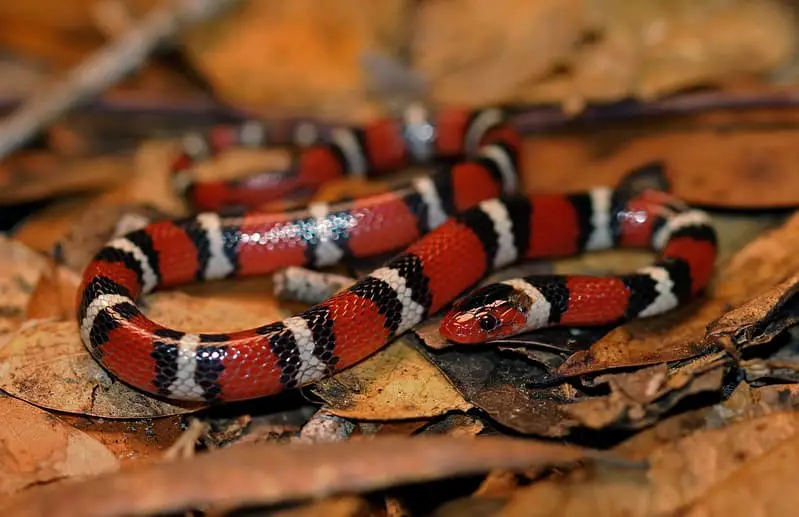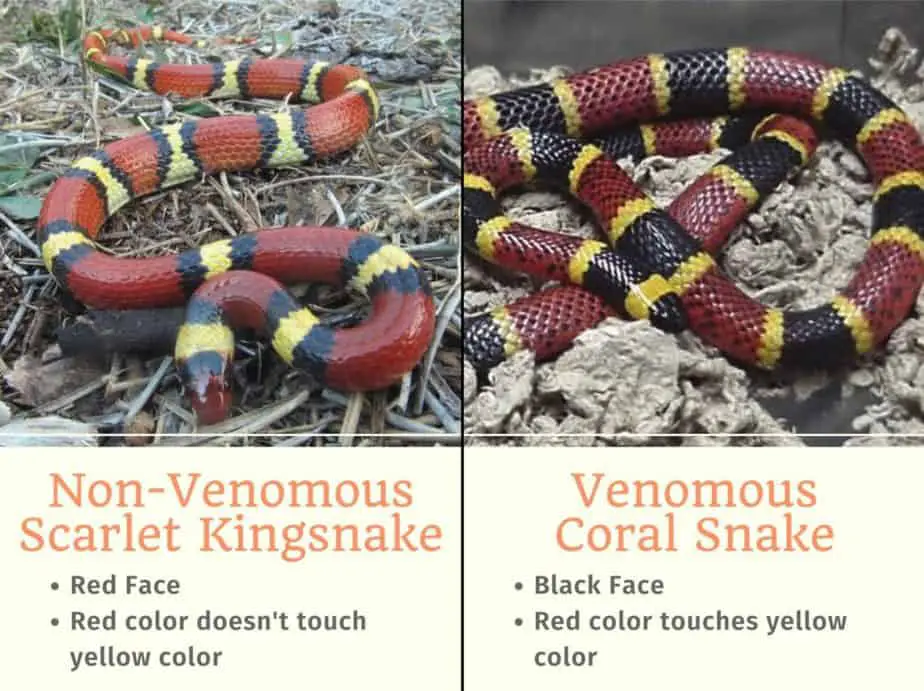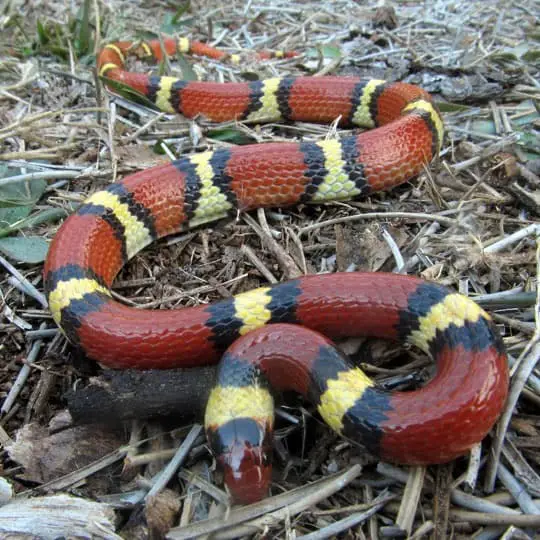The scarlet kingsnake is a nonvenomous snake that can be found throughout the Southeastern United States. It is often confused with the highly venomous eastern coral snake that can be found in a similar territory.
Description
The scarlet kingsnake is a colorful snake with alternating black, yellow or white, black and red crossbands. The yellow or white bands are relatively narrow, surrounded by two narrow black bands. The red bands are much broader. Juvenile snakes have the same appearance but they do normally not have any yellow coloration. The initially white crossbands will turn yellow over time.

The scarlet kingsnake has adapted its appearance to that of the venomous coral snake. Mimicing the deadly snake means that many natural predators will not get too close to it. Even though the two species look very similar at first glance, they can be easily distinguished. Below are two ways to tell the difference.
How to tell the difference between kingsnake and coral snake?
The scarlet kingsnake looks very similar to the highly venomous coral snake. Since it also shares a large part of its range with the potentially deadly snake, the two are often confused. The easiest way to distinguish nonvenomous snakes from the coral snake is the color of the head. The scarlet kingsnake, the scarlet snake, another similar-looking nonvenomous snake, and the milk snake have a red head. The venomous coral snake has a black head and neck.
Also, the nonvenomous kingsnake (and other nonvenomous, similar-looking snakes) never has two warning colors (red, orange, yellow) touching each other. There is always a black crossband between red and yellow. The venomous coral snake has red and yellow right next to each other.

Size
Scarlet kingsnakes are generally also smaller than coral snakes. Adult specimen reach an average length of 15-20 inches (38-50 cm). The largest ever recorded scarlet kingsnake was almost 27 inches (70cm) long.
Diet and Hunting Behavior
Due to its size, this snake feeds mostly on reptiles such as smaller snakes and lizards as well as small mammals. The scarlet kingsnake is an excellent climber and often waits in ambush in trees. It first fixates its prey with a bite and then wraps its body around it. After the prey animal is soffocated, it ingests it as a whole.
Bite
For humans, the bite of the scarlet kingsnake is absolutely not dangerous. It is a nonvenomous snake and does not have large fangs that could generate a medically significant bite. Any bite should be disinfected to avoid secondary infection.
However, due to its similarity with the potentially deadly coral snake, you should be able to rule out a coral snake bite 100%. A coral snake bite may only have minor effets at first and severe symptoms often only appear after 24 hours after the bite. Once the symptoms have set in, seeking medical attention may already be too late. Therefore you should always consult a medical professional if you are unsure what red, black and yellow snake has bitten you.
Habitat
The scarlet kingsnake is a nocturnal animal and spends a large share of its life underground. Encounters with humans are therefore fairly rare. The scarlet kingsnakes lives in a variety of habitats ranging from dense pine forests to hammocks and cultivated fields. It generally prefers humid environments.
Scarlet kingsnake range in the USA
The scarlet kingsnake can be found throughout the Southeastern United States. Therefore, its range greatly overlaps with the similar-looking and highly-venomous eastern coral snake. While the coral snake is mostly found in coastal regions up to 60 miles (100 km) inland, the scarlet kingsnake has a greater range that reaches up north through Tennessee, Kentucky and Virginia.
The scarlet kingsnake can be found in the following U.S. States: Southeastern Louisiana, Mississippi, Alabama, Georgia, Florida, South Carolina, North Carolina, Tennessee, Southern and Eastern Kentucky and Southern Virginia.
Scientific classification of Lampropeltis elapsoides
- Kingdom: Animalia
- Phylum: Chordata
- Class: Reptilia
- Order: Squamata
- Suborder: Serpentes
- Family: Colubridae
- Genus: Lampropeltis
- Species: Lampropeltis elapsoides
In the past, the scarlet kingsnake has previously been considered a subspecies of Lampropeltis triangulum, the milk snake. Therefore, it is commonly also still called scarlet milk snake.
